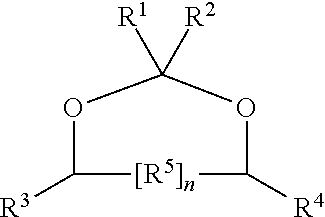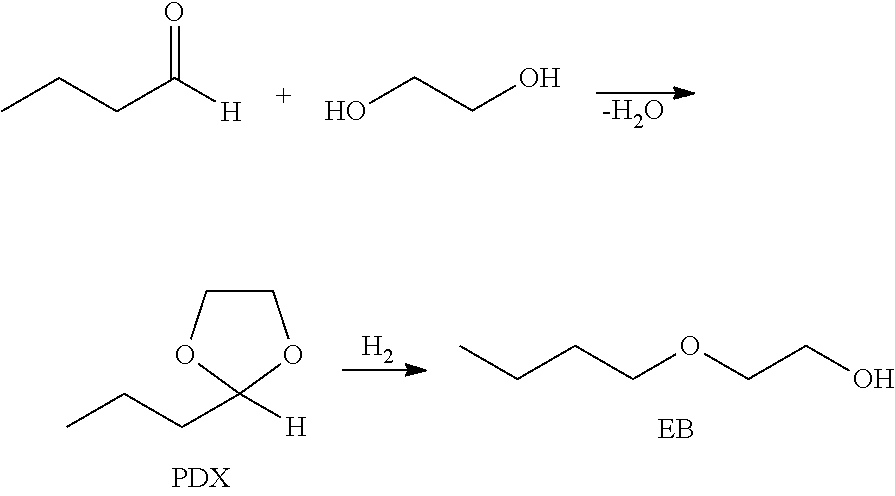Production of hydroxy ether hydrocarbons by liquid phase hydrogenolysis of cyclic acetals or cyclic ketals
a technology of cyclic acetals and hydroxy ethers, which is applied in the preparation of ethers, organic compounds, organic chemistry, etc., can solve the problems of undesirable molecular weight distributions, poor selectivity of reactions, and inefficient conventional processes, and achieves high selectivity
- Summary
- Abstract
- Description
- Claims
- Application Information
AI Technical Summary
Benefits of technology
Problems solved by technology
Method used
Image
Examples
example 1
Production of 2-butoxyethanol (EB)
[0096]100 g of ethylene glycol (EG) and 20 g of 2-propyl-1,3-dioxolane (PDX) were combined in a 300 mL autoclave with 0.50 g of 5% (by weight) Pd on carbon catalyst. The autoclave was sealed and purged twice with N2 and once with H2. The reactor was charged with H2 and heated to 150° C. The reactor was then brought to an operating pressure of 6.89 MPa and stirring commenced at 750 rpm. Pressure was maintained through the duration of the experiment. After 2 h, the autoclave was cooled and remaining gas vented. The autoclave was opened, its contents filtered, and the filtrate analyzed by gas chromatography (GC). 96.3% conversion of PDX and 97.3% selectivity to EB were observed. The only non-selective product observed was 1,2-dibutoxyethane (EG dibutyl ether). Results from Examples 2-6, carried out in a similar manner, are presented in Table 1.
TABLE 1CatalystTemperaturePressureLoadingReactionPDXEBExample(° C.)(MPa)(g)Time (h)ConversionSelectivity220020...
example 8
Production of 2-propoxyethanol (EP)
[0100]100 g of EG and 20 g of 2-ethyl-1,3-dioxolane (EDX) were combined in a 300 mL autoclave with 1.0 g of 5% (by weight) Pd on carbon catalyst. The autoclave was sealed and purged twice with N2 and once with H2. The reactor was charged with H2 and heated to 200° C. The reactor was then brought to an operating pressure of 3.44 MPa and stirring commenced at 750 rpm. Pressure was maintained through the duration of the experiment. After 1 h, the autoclave was cooled and remaining gas vented. The autoclave was opened, its contents filtered, and the filtrate analyzed by gas chromatography (GC). The reactor contained 0.52 g of EDX, 16.4 g of EP, 5.86 g of 1,2-dipropoxy-ethane, 0.51 g of mono propionate ester of EG, and 100.9 g of EG. This result corresponds to 97.4% conversion of acetal and 82.6% selectivity to EP.
example 9
Production of 2-(2-ethylhexyloxy)ethanol
[0101]100 g of EG and 20 g of 2-(1-ethyl-pentyl)-1,3-dioxolane were combined in a 300 mL autoclave with 1.5 g of 5% (by weight) Pd on carbon catalyst. The autoclave was sealed and purged twice with N2 and once with H2. The reactor was charged with H2 and heated to 200° C. The reactor was then brought to an operating pressure of 6.89 MPa and stirring commenced at 750 rpm. Pressure was maintained through the duration of the experiment. After 1 h, the autoclave was cooled and remaining gas vented. The autoclave was opened and its contents filtered. The filtrate separated into two layers with an EG rich layer on the bottom and an organic 2-(2-ethylhexyloxy)ethanol rich layer on top. The two layers were analyzed by gas chromatography (GC) and the combined results from those analyses showed 4.82 g of dioxolane, 12.5 g of 2-(2-ethylhexyloxy)ethanol, 0.77 g of diether, 0.40 g of 2-ethyl-hexanol, and 101 g of EG: a 76.5% conversion of acetal and 78.6% ...
PUM
| Property | Measurement | Unit |
|---|---|---|
| Temperature | aaaaa | aaaaa |
| Temperature | aaaaa | aaaaa |
| Fraction | aaaaa | aaaaa |
Abstract
Description
Claims
Application Information
 Login to View More
Login to View More - R&D
- Intellectual Property
- Life Sciences
- Materials
- Tech Scout
- Unparalleled Data Quality
- Higher Quality Content
- 60% Fewer Hallucinations
Browse by: Latest US Patents, China's latest patents, Technical Efficacy Thesaurus, Application Domain, Technology Topic, Popular Technical Reports.
© 2025 PatSnap. All rights reserved.Legal|Privacy policy|Modern Slavery Act Transparency Statement|Sitemap|About US| Contact US: help@patsnap.com



